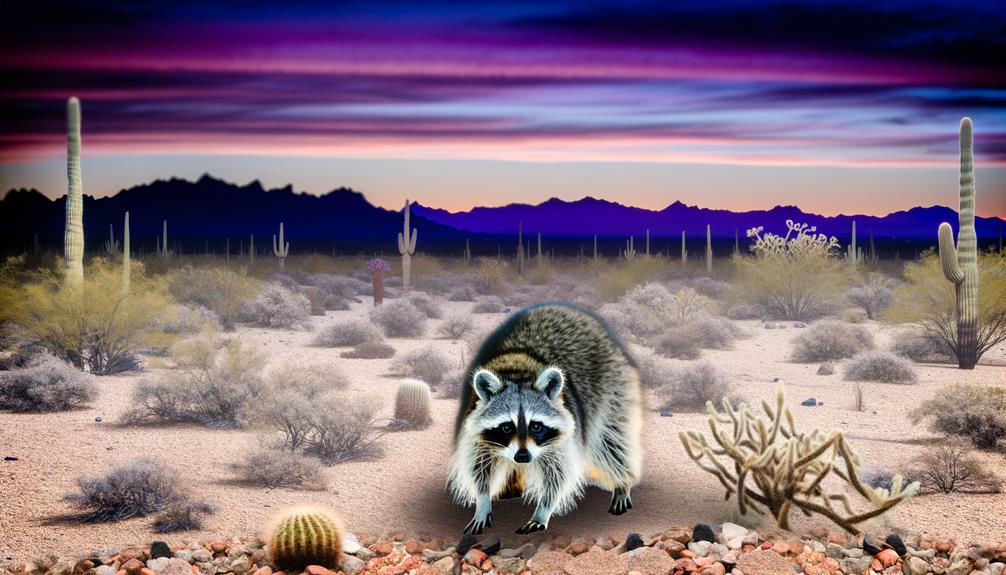How Do Raccoons Live in Arizona and How Can You Coexist?
Yes, raccoons (Procyon lotor) do live in Arizona. They exhibit high ecological plasticity, allowing them to thrive in diverse habitats across the state.
Adaptations such as nocturnal activity and efficient kidneys enable survival in Arizona's arid climate. Raccoons utilize natural shelters and maintain an omnivorous diet, feeding opportunistically.
They are also highly adaptable to urban environments, exploiting anthropogenic food sources and denning in artificial structures. Predators like coyotes and bobcats influence their behavior and survival.
Conservation efforts focus on habitat preservation and public education to maintain stable raccoon populations. Continue to discover the intricate behaviors and adaptive strategies of Arizona's raccoons.

Key Takeaways
- Procyon lotor is the primary native raccoon species in Arizona.
- Raccoons adapt well to diverse habitats found in Arizona.
- They exhibit nocturnal activity patterns to cope with the arid climate.
- Raccoons can thrive in both urban and suburban environments across the state.
- Conservation efforts help maintain stable raccoon populations in Arizona.
Raccoon Characteristics

Characterized by their distinctive black facial mask and ringed tail, raccoons (Procyon lotor) exhibit a range of physical and behavioral traits that have enabled them to adapt successfully to diverse environments, including the arid regions of Arizona.
Notable for their dexterous front paws, raccoons can manipulate objects and open containers, which facilitates foraging. Their omnivorous diet includes fruits, nuts, insects, and small vertebrates, allowing for dietary flexibility in variable ecosystems.
Additionally, raccoons possess highly developed nocturnal vision, aiding in nighttime activity. Behavioral adaptations, such as opportunistic feeding and den utilization, further contribute to their resilience.
These traits collectively underscore the raccoon's adaptability, making them a prevalent species even in less hospitable climates like Arizona.
Native Raccoon Species
In Arizona, the native raccoon species Procyon lotor is the primary representative of the genus, exhibiting unique adaptations to the state's diverse habitats. This species, commonly known as the common raccoon, demonstrates remarkable ecological plasticity, allowing it to thrive in various environments, from riparian zones to urban areas.
Morphologically, Procyon lotor possesses dexterous forepaws, facilitating foraging and manipulation of food items. Behavioral studies indicate nocturnal activity patterns, aiding in avoidance of diurnal predators.
Population density estimates suggest a stable presence, with data indicating 1-2 raccoons per square kilometer in suitable habitats. Genetic analyses reveal limited subspecies differentiation, aligning with broader North American populations.
These adaptations underscore the species' resilience and ecological versatility in Arizona.
Arizona's Climate and Geography

Arizona's climate is primarily arid, with stark variations in temperature and precipitation influenced by its diverse topography. The state encompasses several climatic zones, ranging from desert basins to forested mountain ranges. These variations create distinct microclimates that affect local flora and fauna.
Key geographical and climatic features include:
- Sonoran Desert: Characterized by extremely high temperatures and minimal rainfall, especially in summer.
- Colorado Plateau: Cooler with more precipitation, supporting different vegetation types compared to desert regions.
- Mogollon Rim: An intermediary zone featuring pine forests and moderate temperatures.
- Sky Islands: High-elevation areas with unique ecosystems, notably cooler and wetter than surrounding lowlands.
Understanding these variations is crucial for studying species distribution and habitat suitability in Arizona.
Adaptation to Desert Life
The diverse climatic zones and geographical features of Arizona necessitate specialized adaptations among its wildlife to thrive in desert environments.
Raccoons (Procyon lotor) exhibit several physiological and behavioral adaptations that enable survival in arid conditions. These include nocturnal activity patterns, which minimize water loss and reduce heat exposure. Raccoons also possess highly efficient kidneys, allowing them to conserve water by producing concentrated urine.
Moreover, their omnivorous diet and opportunistic feeding behavior enable them to exploit a variety of food sources, from insects to fruits, which are sporadically available in desert ecosystems. Additionally, raccoons utilize natural shelters such as rock crevices and burrows to escape extreme temperatures. These adaptive strategies collectively enhance their resilience in the challenging desert habitats of Arizona.
Urban and Suburban Habitats

Raccoons in Arizona have demonstrated significant adaptability to urban and suburban environments, showing a marked increase in tolerance to human presence. Studies indicate that these animals frequently forage in residential areas, exploiting anthropogenic food sources such as garbage and pet food.
This behavior not only underscores their ecological versatility but also raises important considerations for urban wildlife management.
Adaptation to Human Presence
In urban and suburban habitats, raccoons (Procyon lotor) exhibit remarkable behavioral plasticity, enabling them to thrive in environments heavily influenced by human activity. This adaptability is evidenced by their ability to exploit diverse resources and modify their behavior to minimize risks.
Key adaptations include:
- Nocturnal Activity: Reduced human interaction by being active primarily at night.
- Dietary Flexibility: Consumption of a wide range of food sources, from natural to anthropogenic.
- Denning Behavior: Use of artificial structures such as attics and chimneys for shelter.
- Problem-Solving Skills: Advanced cognitive abilities to navigate human-made obstacles and access food.
These behavioral adaptations facilitate their survival in human-dominated landscapes, demonstrating their ecological versatility.
Foraging in Residential Areas
While foraging in residential areas, raccoons exhibit a highly opportunistic feeding strategy, capitalizing on readily available anthropogenic food sources such as garbage, pet food, and garden produce. This behavior is facilitated by their dexterous forepaws and keen olfactory senses.
Studies indicate that urban and suburban habitats provide raccoons with abundant nutritional resources, resulting in higher population densities compared to rural areas. Data from urban ecology research show increased raccoon activity correlated with waste management practices and food availability.
Moreover, raccoons' ability to adapt to varied human-induced environments underscores their ecological plasticity. This adaptability raises concerns regarding potential human-wildlife conflicts, necessitating effective management strategies to mitigate negative interactions while preserving urban ecological balance.
Food Sources in Arizona
Various food sources, both natural and anthropogenic, greatly influence the dietary habits of raccoons in Arizona. Raccoons are opportunistic feeders, adapting their diet based on availability and seasonality. In Arizona, their diet is diverse due to the region's ecological variety.
Key food sources include:
- Insects and small invertebrates: Abundant in riparian zones and provide essential protein.
- Fruits and nuts: Found in both natural habitats and urban gardens, offering carbohydrates and essential nutrients.
- Small mammals and birds: Available in desert and forested areas, providing necessary fats and proteins.
- Human refuse: Frequently encountered in urban settings, contributing significantly to their diet.
These varied sources allow raccoons to thrive in different environments, from arid deserts to urban landscapes.
Seasonal Behavior Patterns

Understanding the dietary flexibility of raccoons in Arizona provides a foundation for analyzing their seasonal behavior patterns. These patterns are markedly influenced by changes in food availability and environmental conditions.
During spring and summer, raccoons exhibit increased nocturnal activity, capitalizing on the abundance of fruits, insects, and small vertebrates.
Conversely, in autumn and winter, their activity diminishes as they adapt to the scarcity of resources. They often forage in human-dominated landscapes for sustenance.
Data indicate that raccoons may enter periods of torpor during extreme cold spells, though true hibernation is uncommon. Additionally, seasonal water availability heavily dictates their movement patterns, as raccoons require consistent access to hydration sources.
These behavioral adaptations are critical for survival in Arizona's variable climate.
Predators and Threats
Raccoons in Arizona face predation primarily from coyotes, bobcats, and large birds of prey, which have a notable impact on their population dynamics and behavior patterns. These predators influence raccoon activity, compelling them to adopt nocturnal habits and seek refuge in secure dens.
The ecological balance is maintained through these predator-prey interactions. Data indicate that raccoon mortality rates are significantly affected by these natural threats.
Key predators include:
- Coyotes: Opportunistic hunters that actively seek out raccoons.
- Bobcats: Stealthy predators that capitalize on raccoons' foraging behavior.
- Great Horned Owls: Large avian predators that target juvenile raccoons.
- Snakes: Predators that primarily threaten raccoon kits.
Understanding these dynamics is crucial for wildlife management and conservation strategies in Arizona.
Human-Wildlife Interaction

In addition to natural predators, raccoons in Arizona encounter significant interactions with humans, which profoundly influence their behavior and habitat selection.
Urbanization and suburban expansion have encroached upon raccoon habitats, compelling these adaptable mammals to exploit anthropogenic resources. Studies indicate a notable increase in raccoon sightings in urban areas, with a 20% rise over the past decade. Human-provided food sources, such as garbage and pet food, have been correlated with altered foraging patterns.
Additionally, raccoons exhibit behavioral plasticity, adapting to nocturnal activity to avoid human encounters. These interactions often result in human-wildlife conflicts, including property damage and disease transmission.
Understanding these dynamics is essential for managing raccoon populations and mitigating adverse impacts on both humans and wildlife.
Conservation Efforts
Effective conservation efforts for raccoon populations in Arizona necessitate a holistic approach that integrates habitat preservation, public education, and wildlife management strategies.
Key components include:
- Habitat Preservation: Ensuring raccoons have access to suitable environments, including riparian zones and urban green spaces.
- Public Education: Informing communities about the ecological role of raccoons and promoting coexistence strategies to reduce human-wildlife conflicts.
- Wildlife Management: Implementing scientifically backed measures to monitor raccoon populations and address issues such as disease prevention and overpopulation.
- Research Initiatives: Conducting ongoing studies to understand raccoon behavior, health, and habitat requirements within Arizona's unique ecosystems.
These multi-faceted conservation efforts aim to maintain stable raccoon populations while fostering harmonious human-wildlife interactions.
Conclusion
Raccoons exhibit remarkable adaptability, thriving in Arizona's diverse habitats from arid deserts to urban settings. How do these creatures manage to survive in such a harsh environment?
Their behavioral plasticity, nocturnal activity, and omnivorous diet enable them to exploit various resources, while seasonal behavior patterns and urban habitats provide additional survival strategies.
Predation and human interactions pose challenges, yet conservation efforts remain vital for sustaining raccoon populations in Arizona's unique ecosystem.






